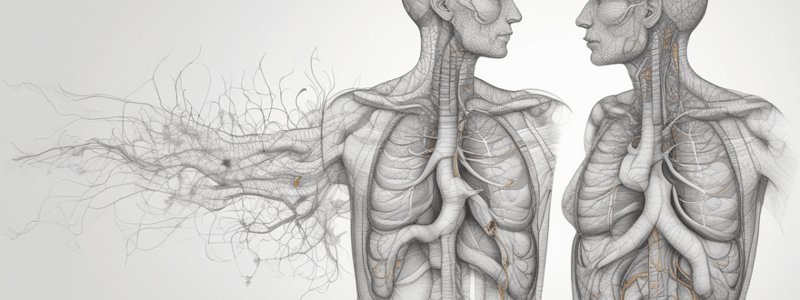Podcast
Questions and Answers
What is the characteristic of Cheyne-Stokes breathing that distinguishes it from normal breathing?
What is the characteristic of Cheyne-Stokes breathing that distinguishes it from normal breathing?
- Shallow breaths at the beginning of each cycle (correct)
- Apnea periods
- Increase in breath depth and volume
- Irregular cycles of breaths
Which of the following conditions is NOT associated with Cheyne-Stokes breathing?
Which of the following conditions is NOT associated with Cheyne-Stokes breathing?
- Traumatic brain injury
- Stroke
- Pneumonia (correct)
- Congestive heart failure (CHF)
What is the effect of congestive heart failure (CHF) on the brain that contributes to Cheyne-Stokes breathing?
What is the effect of congestive heart failure (CHF) on the brain that contributes to Cheyne-Stokes breathing?
- No effect on blood flow to the brain
- Increased blood flow to the brain
- Variable blood flow to the brain
- Reduced blood flow to the brain (correct)
What is the key difference between Cheyne-Stokes breathing and Biot's breathing?
What is the key difference between Cheyne-Stokes breathing and Biot's breathing?
Which of the following is a normal finding in certain individuals?
Which of the following is a normal finding in certain individuals?
What is the term for defective muscular coordination?
What is the term for defective muscular coordination?
What is the prognosis of patients with Biot's breathing?
What is the prognosis of patients with Biot's breathing?
What is the cause of Biot's breathing in patients with increased intracranial pressure?
What is the cause of Biot's breathing in patients with increased intracranial pressure?
What is the primary characteristic of hyperpnea compared to normal breathing patterns?
What is the primary characteristic of hyperpnea compared to normal breathing patterns?
What is the term for hyperpnea caused by diabetic ketoacidosis?
What is the term for hyperpnea caused by diabetic ketoacidosis?
What is the primary cause of agonal breathing?
What is the primary cause of agonal breathing?
What is the characteristic of agonal breathing that differs from Biot's breathing?
What is the characteristic of agonal breathing that differs from Biot's breathing?
What is the function of the apneustic center in the pons?
What is the function of the apneustic center in the pons?
What is the consequence of damage to the apneustic center in the pons?
What is the consequence of damage to the apneustic center in the pons?
What is the characteristic of apneustic breathing?
What is the characteristic of apneustic breathing?
What is the prognosis of agonal breathing?
What is the prognosis of agonal breathing?
What is the term for the physical signs seen during the process of death?
What is the term for the physical signs seen during the process of death?
Flashcards
Cheyne-Stokes breathing characteristic
Cheyne-Stokes breathing characteristic
Shallow breaths are seen at the beginning of each cycle.
What is Biot's breathing?
What is Biot's breathing?
Characterized by irregular patterns of rate and depth with intermittent periods of apnea. Strongly associated with increased intracranial pressure and damage to the medulla.
Hyperpnea characteristic
Hyperpnea characteristic
Unlike normal breathing patterns, breaths are faster and deeper.
Kussmaul's breathing
Kussmaul's breathing
Signup and view all the flashcards
Agonal breathing
Agonal breathing
Signup and view all the flashcards
Primary cause of Agonal breathing
Primary cause of Agonal breathing
Signup and view all the flashcards
Apneustic center function
Apneustic center function
Signup and view all the flashcards
Apneustic breathing characteristic
Apneustic breathing characteristic
Signup and view all the flashcards
Prognosis of agonal breathing?
Prognosis of agonal breathing?
Signup and view all the flashcards
Agonal signs
Agonal signs
Signup and view all the flashcards
Ataxia
Ataxia
Signup and view all the flashcards
Cause of Biot's breathing
Cause of Biot's breathing
Signup and view all the flashcards
Consequence that leads to apneustic breathing?
Consequence that leads to apneustic breathing?
Signup and view all the flashcards
CHF effect on the brain
CHF effect on the brain
Signup and view all the flashcards
Key difference: Cheyne-Stokes and Biot's
Key difference: Cheyne-Stokes and Biot's
Signup and view all the flashcards
Normal finding (sometimes)
Normal finding (sometimes)
Signup and view all the flashcards
Prognosis of Biot's breathing
Prognosis of Biot's breathing
Signup and view all the flashcards
Study Notes
Additional Breathing Patterns
- Hyperpnea is a breathing pattern that is faster and deeper than normal, often seen after exercise when O2 consumption and CO2 production increase.
- Abnormal hyperpnea can be caused by pathologies, especially sepsis, and is known as Kussmaul's breathing when caused by diabetic ketoacidosis.
Agonal Breathing
- Agonal breathing is a pattern of very slow (3-4 per minute) and very shallow inspirations followed by long irregular periods of apnea.
- Agonal breathing is often seen in patients nearing death and is usually caused by cerebral ischemia due to extreme hypoxia or anoxia.
Apneustic Breathing
- Apneustic breathing is characterized by deep inspiratory gasps held for some seconds before expiration.
- Apneusis is caused by damage to the apneustic center in the pons of the medulla, which acts as a "cut off switch" to control the depth of inspiration.
Cheyne-Stokes Breathing
- Cheyne-Stokes breathing is a pattern of regular cycles of breaths that begin shallowly, increase in depth, and reach a peak before diminishing.
- Each cycle is followed by a period of apnea.
- Cheyne-Stokes breathing is seen in patients with stroke, traumatic brain injury, brain tumor, and congestive heart failure (CHF).
- CHF reduces blood flow to the brain, causing a lag between arterial PaCO2 changes and the medullary response.
Biot's Respiration
- Biot's respiration, also called cluster breathing or ataxic breathing, is characterized by groups of quick shallow inspirations followed by long, irregular periods of apnea.
- Biot's breathing differs from Cheyne-Stokes in that the inspired volumes have depths that are fairly consistent.
- Biot's breathing is often seen in patients with increased intracranial pressure due to damage to the medulla or pressure on the medulla from herniation.
Studying That Suits You
Use AI to generate personalized quizzes and flashcards to suit your learning preferences.




